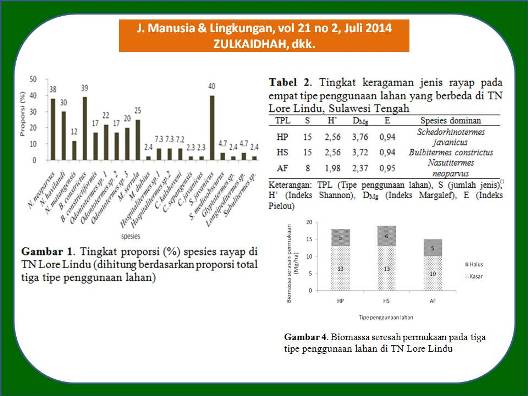
KAJIAN KOMUNITAS RAYAP AKIBAT ALIH GUNA HUTAN MENJADI AGROFORESTRI DI TAMAN NASIONAL LORE LINDU, SULAWESI TENGAH (Termites Community Impact of Forest Conversion to Agroforestry in Lore Lindu National Park, Central Sulawesi)
Zulkaidhah Zulkaidhah(1*), Musyafa Musyafa(2), Soemardi Soemardi(3), Suryo Hardiwinoto(4)
(1) Program Doktor Ilmu Kehutanan, Fakultas Kehutanan UGM, Jl.Agro No.1 Bulaksumur, Sleman Yogyakarta 55281
(2) Fakultas Kehutanan Universitas Gadjah Mada, Bulaksumur Yogyakarta 55281
(3) Fakultas Kehutanan Universitas Gadjah Mada, Bulaksumur Yogyakarta 55281
(4) Fakultas Kehutanan Universitas Gadjah Mada, Bulaksumur Yogyakarta 55281
(*) Corresponding Author
Abstract
ABSTRAK
Penelitian ini bertujuan untuk mengkaji komunitas rayap akibat alih guna hutan dan hubungannya dengan faktor lingkungan. Penelitian dilaksanakan dari bulan Desember 2011 sampai Juni 2013. Dilaksanakan di wilayah Taman Nasional Lore Lindu di sekitar Desa Rahmat, Kecamatan Palolo, Kabupaten Sigi. Pengamatan rayap dilakukan dengan menggunakan metode transek. Parameter yang diamati adalah parameter lingkungan, iklim mikro, sifat fisik dan kimia tanah. Total diversitas rayap yang ditemukan adalah 20 spesies, yang terdiri dari 15 spesies pada hutan primer, 15 spesies pada hutan sekunder dan 8 spesies pada agroforestri. Biomassa pohon tertinggi pada hutan primer (620,91 Mg/ha), nekromas dan jumlah seresah tertinggi pada hutan sekunder yaitu masing-masing 8,22 Mg/ha dan 19 Mg/ha. Hasil penelitian ini membuktikan bahwa alih guna hutan menjadi agroforestri diikuti oleh perubahan komunitas rayap. Suhu tanah dan suhu udara meningkat setelah alih guna hutan.
ABSTRACT
This study was conducted to evaluate the termines community impact forest conversion and its relation with the environmental factors. It was conducted from December 2011 to June 2013 and implemented in Lore Lindu National Park located in around of Rahmat village, subdistrict of Palolo, district of Sigi. The observation of termites community was performed using method of transect. The measured parameters were environmental parameters, microclimate, and physic and chemical characteristics of the soil. There were 20 species found totally, consisted of 15 species in primary forest, 15 species in secondary forest, and 8 species in agroforestry. The highest biomass of tree in primary forest was 620.90 Mg/ha, whereas the necromass and highest amount of litter in secondary forest were respectively 8.22 Mg/ha and 19 Mg/ha. Land use change in TN.Lore Lindu was alearly followed by the change of termites diversity. The soil and water temperatures were increased.
Keywords
Full Text:
ARTIKEL LENGKAP (PDF) (Bahasa Indonesia)References
Aini F.K., Susilo F.X., Yanuwiadi B., dan Hairiah K. 2006. Meningkatnya Sebaran hama Rayap Odontotermes spp. Setelah Alih Guna Hutan menjadi Agroforestri Berbasis Kopi: Efek Iklim Mikro dan Ketersediaan makanan Terhadap Kerapatan Populasi. Agrivita, 28 (3): 221 – 237. Baumgardner, M.C. 2007. Forest Fragmentation and It’s Effects on Arthropod Populations in Small vs Large Forests in Northwest Ohio. Thesis. Bowling Green State University, Ohio. Galle, R. 2008. The Effect of Naturally Fragmented Landscape on the Spider Assemblages. Department of Ecology University of Szeged. North-Western J. Zoology, 4:61-71 Genet, J.A. Kristen, S.G. Thomas, M.B. Peter, G.M. dan Ariel, E.L. 2001. Response of Termite Community and Wood Decomposition Rates to Habitat Fragmentation in a Subtropical Dry Forest. Tropical Ecology, 42:35-49. Jones, D.T. dan Prasetyo, A.H. 2002. A Survey of The Termites (Insecta : Isoptera) of Tabalong District, South Kalimantan, Indonesia. National University of Singapore.The Raffles Bulletin of Zoology, 50(1):117 – 128. Jones, D.T., Susilo, F.X., Bignell, D.E., Hardiwinoto, S., Gillison, A.N., dan Eggleton, P. 2003. Termite Assemblage Collapse Along A Land Use Intensification Gradient In Lowland Central Sumatera, Indonesia. J. Appl. Ecology, 40:380 – 391. Kief, J. 2001. Indigenous Variety Development in Food Crops Strategies on Timor: Their Relevance for In-Situ Biodiversity Conservation and Food Security. Indigenous Knowledge Development Monitor, (7):7 – 15. Martinus, C., Hofer H., Garcia M.V.B., Rombke J., dan Hanagarth W. 2004. Litter Fall, Litter Stocks and Decomposition Rates in Rainforest and Agroforestry Sites in Central Amazonia. NC Agroecosystem, 68: 137 – 154. Miyashita, T., Shinkai, A., dan Chida, T. 1998: The Effects of Forest Fragmentation on Web Spider Communities in Urban Areas. Biological Conservation, 86:357-364 Richard, D.G. 2002. Feeding Group Responses of A Neotropical Termite Assemblage to Rain Forest Fragmentation. Oecologia Journal, 133(2):233 – 242. Rusdiana O. dan Lubis R.S. 2012. Pendugaan Korelasi Antara karakteristik Tanah Terhadap Cadangan Karbon (Carbon Stock) Pada Hutan Sekunder. Jurnal Silvikultur Tropika, 3(1):14 – 21. Sahabuddin. 2003. Pemanfaatan Serangga Sebagai Bioindikator Kesehatan Hutan. Pengantar Falsafah Sains. Program Pascasarjana (S3) Institut Pertanian Bogor. Bogor Sahabuddin, Manuwoto, S. Purnama, H. Christian, H.S. dan Woro, A.N. 2007. Respons Kumbang Koprofagus (Coleoptera: Scarabaeidae) Terhadap Perubahan Struktur Vegetasi Pada Beberapa Tipe Habitat di Taman Nasional Lore Lindu, Sulawesi Tengah. Biodiversitas, 8(1):01 – 06 Thapa, R.S. 1981. Termites of Sabah. Sabah Forest 12: 1-374. Tho, Y.P. 1992. Termites of Peninsular Malaysia.Malayan Forest Record N. Forest 36. Research Institute Malaysia : 224.
Article Metrics
Refbacks
- There are currently no refbacks.
Copyright (c) 2017 Jurnal Manusia dan Lingkungan







